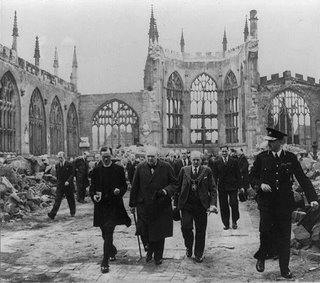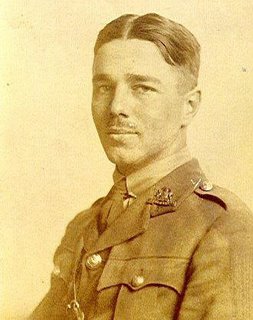Britten's War Requiem
 If any choral work of the latter half of the 20th century has achieved classic status, it is Benjamin Britten’s War Requiem. Commissioned for the rededication of Coventry Cathedral, reduced to rubble by German bombing during the Second World War, this conflation of the ancient Mass for the Dead with war-soaked poems of Wilfred Owen — himself a casualty of the First World War — was presented Sunday by the Cathedral Choral Society to conclude its season. The event, prefiguring America’s Memorial Day next weekend, in fact commemorated the anniversary of the Axis surrender to the Allies ending the Second War in Europe: May 8, 1945.
If any choral work of the latter half of the 20th century has achieved classic status, it is Benjamin Britten’s War Requiem. Commissioned for the rededication of Coventry Cathedral, reduced to rubble by German bombing during the Second World War, this conflation of the ancient Mass for the Dead with war-soaked poems of Wilfred Owen — himself a casualty of the First World War — was presented Sunday by the Cathedral Choral Society to conclude its season. The event, prefiguring America’s Memorial Day next weekend, in fact commemorated the anniversary of the Axis surrender to the Allies ending the Second War in Europe: May 8, 1945.
The War Requiem, a favorite of Mstislav Rostropovich during his tenure as National Symphony Orchestra director (Galina Vishnevskaya, his wife, had been chosen by the composer to represent the Soviet Union – next to Britain with Peter Pears and Germany with Dietrich Fischer-Dieskau – as one of three soloists in the 1963 premiere but was blocked from the first performance by the Soviet minister of Culture, Yekaterina Furtseva), was led by J. Reilly Lewis, also Music Director of the Washington Bach Consort. Presenting a major, complex work such as this — multiple choruses, three soloists, chamber ensemble, and large orchestra — is a daunting task anywhere, but the cathedral setting brings unique challenges. Balancing such large forces in both time and space is not so easy without concert hall acoustic reflections, sightlines are broken up, and the slow decay of notes hanging in the air makes it difficult to steer the music precisely. True, the work was designed for cathedral performance and premiered at Coventry — but to accurately render this music in all its complexity, a concert acoustic might be preferred.
B. Britten, War Requiem, Britten / Pears, Fischer-Dieskau, Vishnevskaya |
To grasp the magnitude of this achievement, know that Britten not only blends the Mass and Owen’s searing poems, he sets the two at war with each other with rival performing forces: full chorus, orchestra, and soprano soloist, punctuated by boys’ choir with organ accompaniment for the Mass; chamber ensemble with tenor and baritone soloists for the poems. The opening Requiem Aeternam gently introduces this structure, with full chorus followed (separately) by boys’ chorus leading into Owen’s Anthem for Doomed Youth, sung here by British tenor Robin Leggate (recently Mime in the Washington National Opera production of Das Rheingold). The music for chamber ensemble, which accompanies tenor and baritone, strikes me as a take-off on Weimar cabaret music: cynical, acrid, and acerbic.
 The pivotal Dies Irae introduces the soprano (Liber scriptus), who acts as a kind of interlocutor for the choir, while tenor, baritone, and chamber ensemble challenge war itself. Spiritual regard for the dead, juxtaposed with lashing denunciation of the impersonal forces that bring death. All forces joined, the composer moves between each group with consummate skill, bringing nobility, power, and intense personal feeling into stark contrast. The main chorus, which carries the work, delivered Britten’s sometimes tortured lines with remarkable intensity and precision.
The pivotal Dies Irae introduces the soprano (Liber scriptus), who acts as a kind of interlocutor for the choir, while tenor, baritone, and chamber ensemble challenge war itself. Spiritual regard for the dead, juxtaposed with lashing denunciation of the impersonal forces that bring death. All forces joined, the composer moves between each group with consummate skill, bringing nobility, power, and intense personal feeling into stark contrast. The main chorus, which carries the work, delivered Britten’s sometimes tortured lines with remarkable intensity and precision.Lewis and company were blessed with an outstanding trio of soloists. In addition to Mr. Leggate, soprano Marina Shaguch (Russia) and baritone William Sharp (America) all did the composer proud and honored, in a slightly different way, Britten’s conceit that the original soloists represent the combatants, not just the victors, in the Second War. The singers, benefiting from discrete miking, delivered their parts with precision, passion, and intensity.
Joe Banno, Cathedral Choral Society (Washington Post, May 23) |
I am the enemy you killed, my friendReluctant as I am to draw invidious comparisons, Mr. Sharp’s superb presentation of this pivotal dramatic moment capped the performance for me; as indeed it ushered in the symbolic reconciliation in the music, as full chorus, boys’ chorus, soprano, and tenor-baritone-chamber ensemble truly join for the first time in the work. Not in unison, but in a transcendent unity of different parts, as the “Let us sleep” music gently weaves around the chorus’s “Requiescant in pace.” The rising note on the final syllable of “Amen” ends the work in resignation, hope, and the true spiritual uplift only a truly great work of art can bring. Conflict, aggression, violence, endemic in human experience both public and personal, are subsumed and overwhelmed by the common humanity which binds us all.
I knew you in this dark; for so you frowned
Yesterday through me as you jabbed and killed.
I parried; but my hands were loath and cold.
Let us sleep now…
At the end, a few tears also among the members of the fine orchestra. Lewis was more than ably assisted by Scott Dettra, leading the chamber ensemble, and Michael McCarthy, directing the boys’ chorus (off-stage, in this case behind the nave and out of sight), whose Bach-like chorales help anchor the work in the ancient traditions of Western religious music. A profound, moving and exalting experience.
The Britten was preceded by a very welcome, warm, slightly subdued performance of Arvo Pärt’s Cantus in Memory of Benjamin Britten. The Cathedral Choral Society, while its own season is over, will appear with Leonard Slatkin and the NSO in Mahler’s 8th Symphony, June 8, 9, and 10; and will present a non-subscription performance of Dave Brubeck’s Gates of Justice July 1 at the Cathedral (with the Dave Brubeck Quartet).





















































1 comment:
As one who sang in the performance, I want to thank you for the intelligence of your review, which clearly stems from your knowledge and respect for the music. I suspect that if we had done a poor job, that same knowlede and respect would have informed a well-deserved negative review.
Post a Comment